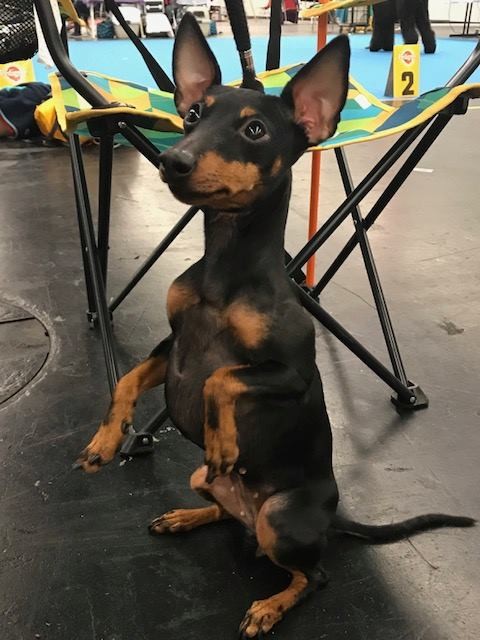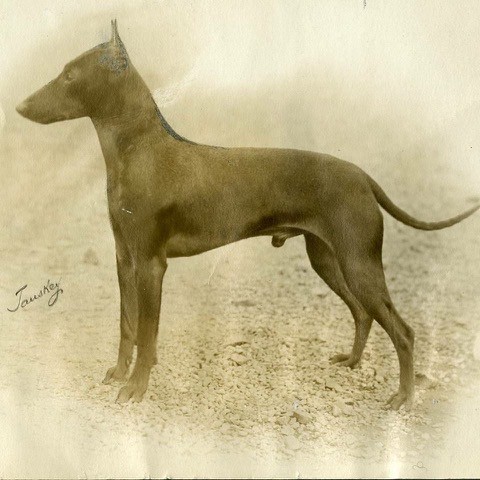... für dich und deinen Hun
Blog
CACIB Nürnberg 13.01.2018
CURIOUS MADCAPS Divine Kate - Kate -
Championklasse
V1
BOB
Alpen Sieger
Judge: Zita Kotlas Sarnjai ( RS )



... grace unser blumenmädchen wünscht ein ruhiges und entspandes wochenende

Manchester Terrier Weight: Part 2 (Breed Standard Comparisons)
The “bomb cyclone” provided some downtime to write this, so it seemed like a good time to move the discussion of Manchester Terrier weight along.
It was actually pointed out to me that as a Toy person (and a Canadian to-boot), perhaps I wasn’t entitled to an opinion on this subject at all. I do take the point, however I’d actually argue that both of those things might make it easier for me to facilitate a fact-based discussion of the topic. Certainly, those who are in the thick of it have many emotions at play, making it hard to divorce current events from the bigger picture questions that really need to be discussed.
I’d also point out that, like many things in life, the Canada-US relationship in this case is much like the mouse and the elephant. As we have already seen based on changes made to the US breed standard in the 1990s, any modifications to the American standard affect Canadian dogs because the genepool in our breed is so heavily based in the US. So, with that in mind I will (with apologies to critics), soldier on as I think this conversation is not only important for SMT breeders but to our entire breed.
With that out of the way, now that we have talked about WHY we use weight as a measurement tool in our breed, I thought it might be helpful to back up a step and look at three associated issues:
1) How size is determined across all breeds.
2) The nature and role of disqualifying faults.
3) The rules around weighing and measuring.
None of these topics is specific to Manchesters alone, in fact to have the most constructive conversation possible it’s important that we try to apply the principles that underlie each as widely as possible while also looking at their relationship to and affect on our breed.
So, let’s start with how size is determined generally in dogs. Here are a few points to think about:
A) Breed Standards as a Whole
For interest’s sake, I did a quick search through AKC breed standards. Now, my numbers jotted on the back of an envelope aren’t scientific but they should be somewhat close. I counted 179 AKC breed standards that specify either prescribed or suggested size ranges in inches, pounds or both. For the sake of brevity, where a breed standard applied to multiple varieties I just counted it once.
Of those 179 breed standards, 94 (53%) contain measurements pertaining to height only; 70 (39%) contain measurements pertaining to height and weight together; and 15 (8%) measure size using weight alone. 54 (30%) of the breed standards that specify a size or size range contain a disqualification for size.
Of the breed standards that contain DQs related to size, 50 (93%) measure size in terms of height and 4 (7%) determine size using weight alone.
Looking at the list of the 15 breeds whose breed standards specify only weight is interesting. These breeds include: Dachshunds, Greyhounds, Boston Terriers, Bulldogs, French Bulldogs, Border Terriers, Brussels Griffon, Chihuahua, English Toy Spaniels, Maltese, Manchesters, Pekingese, Pomeranians, Pugs and Yorkshire Terriers.
Among those breeds, the breed standards for Manchester Terriers, Chihuahuas, Pekingese and French Bulldogs contain disqualifications for size. The Manchester Terrier is the only breed in this group that was not developed as a companion.
![]() ???? Form for Function
???? Form for Function
A few breeds stand out to me when I look at the list of breeds using weight alone as their tool for determining size. For example, the Greyhound’s use of weight seems quite strange to given the breed’s history as a coursing breed (only Greyhounds and Dachshunds are measured by weight in the entire hound group). Looking at the breed standard does provide some clues as to why this may be the case though, and also raises some questions about early breed standards.
Barring formatting, the AKC and CKC Greyhound breed standards both read identically and neither bears an approved or effective date, which tells me that this is likely the breed standard that was in place when the two organizations were formed. Additionally, like the CKC’s Manchester breed standard the Greyhound standard contains a scale of points indicating where and how much emphasis should be placed on different aspects of conformation, providing another indication of its age (most of the point scales have been removed over the years but it was very common in old standards and can still be found in some today). Given weight is such a strange choice for a large breed like this, I wonder if it was simply more common when dog shows began to determine size using weight. It would certainly be very interesting to know if other breeds were originally measured by weight and switched to a height standard at some point (I hope those with other breeds will pipe in if they know!).
The inclusion of the Bulldog and Boston Terrier on the list of weight-based standards is also interesting to me given both share some form of relation genetically and functionally through the same blood sports that the Manchester Terrier breed standard references.
Certainly, we know Bulldogs were popular in bull baiting and were crossed with terriers for the purposes of related sports like rat baiting. Like Manchesters, Boston Terriers also descend from bull and terrier crosses and were themselves used for pit ratting purposes. So the fact that Bulldogs and Bostons continue to use weight is not surprising, though it is notable that neither has an associated disqualification. Just as interesting, however, is the fact that the Bull Terrier, which was developed in parallel with the Manchester, has no reference in their breed standard to size at all.
OK, I’ll stop here—hopefully there are some things to chew on above and I hope others will pipe in.
I’m sure everyone will read something different into the above, but here are my takeaways after having read so many standards:
a) It is very uncommon in the context of modern dog shows for a breed standard to use weight alone as a measurement for size.
b) It is very rare to use weight as the basis for disqualifying a dog, with just 4 breeds (2%) among all of the breed standards I looked at citing weight as a disqualifying fault. Three of those breeds were developed as companions.
c) It is possible that weight was a more common tool for measurement when breed standards were originally written (please chime in if you have info to add).
d) Some of the breeds whose breed standards continue to use weight alone are related historically to Manchesters, either through ancestry or use in similar functions.
Amanda Kelly
... flo möchte aus dem spieleparadies abgehlt werden :-)

Ch. Queensbury Surprise in 1920 ![]() ????
????
![]() ????????《Manchester Terrier》
????????《Manchester Terrier》

... grace
na, kann ich nicht lieb schauen?

bekomme ich jetzt etwas zum knabbern?

das ist lecker

Vaginaler Ausfluss ist bei Hündinnen nicht selten schon vor der ersten Läufigkeit zu beobachten. Eine Antibiotikatherapie bringt häufig keine Veränderung.
https://vetline.de/was-tun-bei-der-junghundvaginitis/150/3518/105500/
... dies ist lediglich als info gedacht, bitte das thema mit dem tierarzt eures vertrauen besprechen.
... haben wir für joy das richtige mäntelchen gefunden, in dem sie richtig glücklich bei den spaziergängen an frischeren tagen mitläuft!
dickes danke an clara und jane!
darf ich vorstellen: joy unser english leo terrier![]()
